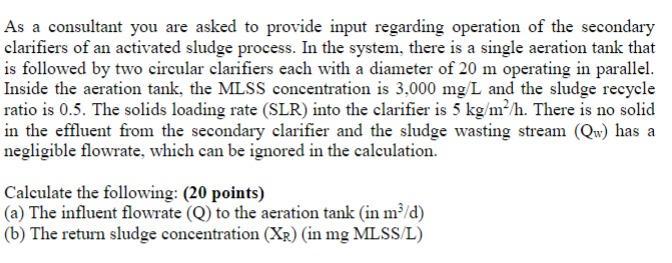Answered step by step
Verified Expert Solution
Question
1 Approved Answer
No copy from others please Please pass the question to another expert if you are not familiar with it. If the answer has no correlation
No copy from others please

| Please pass the question to another expert if you are not familiar with it. If the answer has no correlation with the question, a thumb down will be voted. Thanks for your help! |
yes?
As a consultant you are asked to provide input regarding operation of the secondary clarifiers of an activated sludge process. In the system, there is a single aeration tank that is followed by two circular clarifiers each with a diameter of 20 m operating in parallel. Inside the aeration tank, the MLSS concentration is 3.000 mg/L and the sludge recycle ratio is 0.5. The solids loading rate (SLR) into the clarifier is 5 kg/m/h. There is no solid in the effluent from the secondary clarifier and the sludge wasting stream (Qw) has a negligible flowrate, which can be ignored in the calculation. Calculate the following: (20 points) (a) The influent flowrate (Q) to the aeration tank (in m/d) (b) The return sludge concentration (XR) (in mg MLSS/L) As a consultant you are asked to provide input regarding operation of the secondary clarifiers of an activated sludge process. In the system, there is a single aeration tank that is followed by two circular clarifiers each with a diameter of 20 m operating in parallel. Inside the aeration tank, the MLSS concentration is 3.000 mg/L and the sludge recycle ratio is 0.5. The solids loading rate (SLR) into the clarifier is 5 kg/m/h. There is no solid in the effluent from the secondary clarifier and the sludge wasting stream (Qw) has a negligible flowrate, which can be ignored in the calculation. Calculate the following: (20 points) (a) The influent flowrate (Q) to the aeration tank (in m/d) (b) The return sludge concentration (XR) (in mg MLSS/L)Step by Step Solution
There are 3 Steps involved in it
Step: 1

Get Instant Access to Expert-Tailored Solutions
See step-by-step solutions with expert insights and AI powered tools for academic success
Step: 2

Step: 3

Ace Your Homework with AI
Get the answers you need in no time with our AI-driven, step-by-step assistance
Get Started


